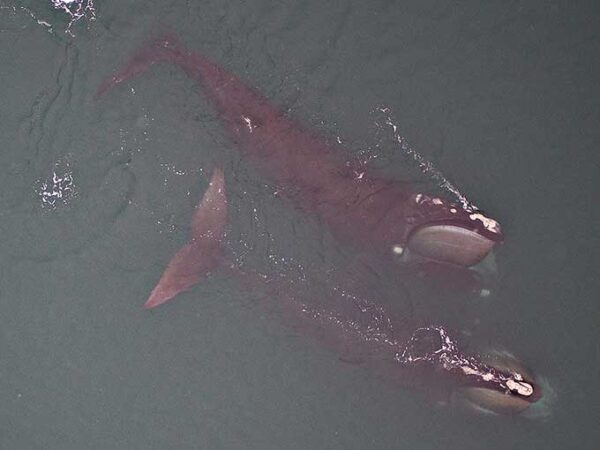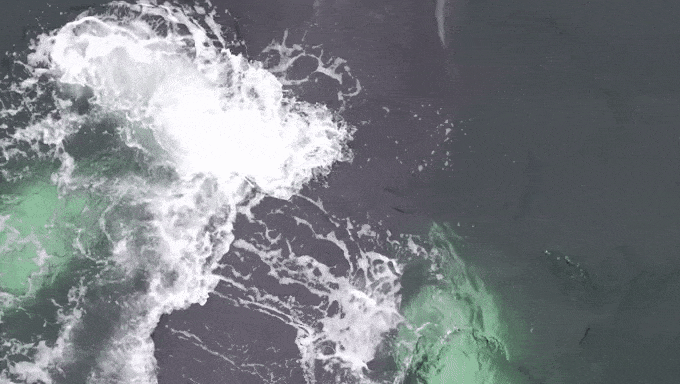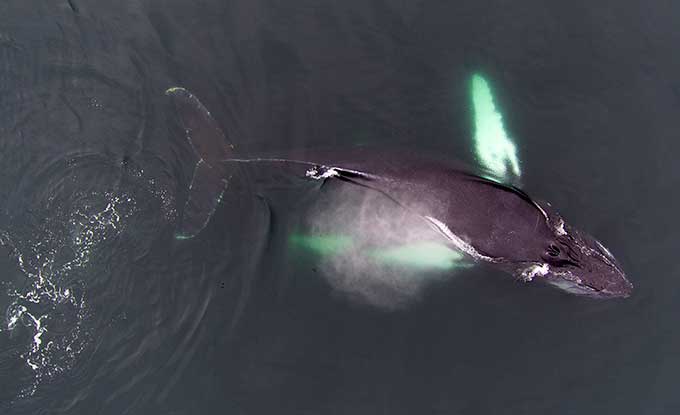What Comes Out of a Whale Spout
All whales have one or two blowholes on top of their heads. This organ started out as a nostril-like feature at the tips of the snouts of whales that lived millions of years ago. Over time, those nostrils slowly moved backwards to the top of a whale's head. This allowed the animals to breathe by skimming the surface of the water. Scientists had thought this change in position, plus a few other adaptations, evolved to keep seawater from entering the whales' respiratory tracts. But no more.
One team has just shown for the first time that seawater enters whale blowholes.
This challenges what scientists thought they knew about blowhole anatomy and whales' respiratory systems. It also increases concerns about what risks pollution, such as oil spills, may pose to whales.
Maria Clara Iruzun Martins is a marine mammal scientist. She joined this project as a visiting student at the Woods Hole Oceanographic Institution in Massachusetts. As part of her work, she watched videos taken by drone aircraft flying above pods of surfacing whales. Some were North Atlantic right whales, others were humpbacks.

Educators and Parents, Sign Up for The Cheat Sheet
Weekly updates to help you use Science News for Students in the learning environment
Thank you for signing up!
There was a problem signing you up.
"You can't take [the whales] out of the water," Martins explains. "They come up, they come down. And that's all we see from them." And that's what makes drones so useful, she adds. They allow people to watch whales without approaching them.
She worked with biologist Michael Moore at Woods Hole. He had collected the videos for another study. While watching them, he noticed how seawater covered open blowholes. Puzzled, he shared the videos with Martins.

She combed through the videos. Along the way, she recorded when the whales breathed and if seawater covered their blowholes. One in every five times the right whales surfaced to inhale, seawater covered their open blowholes. But in humpback whales, this happened nine in every 10 times. What's more, the humpbacks dipped under the water with their blowholes still open.
In the beginning, Martins thought, "This can't be right." If true, it would mark the first evidence of seawater entering blowholes. And that means water was likely entering the whales' upper respiratory tract. But after finishing the video, she no longer had any doubt.
She and her team shared their new findings May 29 in Marine Mammal Science.

What's the big deal?
Humpbacks that routinely inhale seawater might also take in toxic pollutants, such as oil, Martins now worries. During an oil spill, a slick of toxic oily hydrocarbons floats atop the water. As some of it starts to evaporate, these pollutants can linger as toxic vapor right above the water.
Inhaling toxic vapors after a spill can poison marine mammals. But those vapors ultimately drift away. That leaves behind thicker, less volatile parts of the oil. And they, too, can be quite toxic and float for quite a while. Nearby whales may inhale a double whammy: not just the oily vapors but also this floating oil.
Scientists know oil can poison the whales. They aren't yet sure how far this oil might move into their respiratory tracts. But Martins says there is a reason to be concerned since they now know whales can inhale oil with any seawater.
Findings from this study also could inform future whale research. Scientists regularly use drones or long poles equipped with petri dishes to collect blow samples. This allows them to study a whale's health. But if these animals inhale seawater, then they also could spout it out, which might ruin samples.

"This is particularly concerning for my research," says Justine Hudson. She's a marine mammal scientist. While she was a graduate student, she had tried to study cortisol in beluga whales in Manitoba, Canada. Cortisol is a hormone that rises in animals that are stressed. Levels in her samples tended to be low. "I can't tell if that's because the animal I collected it from had a low stress level," she now says, "or if it's because the sample was just diluted with a lot of extra seawater."
Measuring how much seawater is in a whale's exhaled blow can help scientists standardize their data. That could make analyses of their blow more reliable.
Blow sampling is a relatively new tool. The finding by Martins' team is a step toward improving that tool, says Vanessa Pirotta. She's a marine scientist at Macquarie University in Sydney, Australia. She's also one of the first to collect blow samples by drone.
Martins hopes to build on her team's new research by examining how and why seawater entry occurs and how it varies across whale species.
Power Words
More About Power WordsAtlantic: One of the world's five oceans, it is second in size only to the Pacific. It separates Europe and Africa to the east from North and South America to the west.
blow: (noun) A term for the materials exhaled by whales through their blowholes. This can include air, mucus, germs and sometimes even seawater.
blowhole: (in biology) Nostrils on the top of the head of a cetacean (whale, porpoise or dolphin) through which the animal breathes. Toothed whales (like orcas) have one, baleen whales, such as right whales, have a pair. (in ecology) A hole in ice through which marine mammals periodically come to breathe. (in Earth science and engineering) A vent (sometimes fitted with a one-way valve) through which air or other gases can escape a tunnel, cave or pipe.
cortisol: Also known as hydrocortisone, this is a hormone produced by the adrenal glands. It can serve as the body's main warning that it is under stress. It helps regulate a wide range of body functions, including how we process the energy in food, create memories and control inflammation.
data: Facts and/or statistics collected together for analysis but not necessarily organized in a way that gives them meaning. For digital information (the type stored by computers), those data typically are numbers stored in a binary code, portrayed as strings of zeros and ones.
drone: A remote-controlled, pilotless aircraft or missile.
evaporate: To turn from liquid into vapor.
evolve: (adj. evolving) To change gradually over generations, or a long period of time. In living organisms, such an evolution usually involves random changes to genes that will then be passed along to an individual's offspring. These can lead to new traits, such as altered coloration, new susceptibility to disease or protection from it, or different shaped features (such as legs, antennae, toes or internal organs).
graduate student: Someone working toward an advanced degree by taking classes and performing research. This work is done after the student has already graduated from college (usually with a four-year degree).
hormone: (in zoology and medicine) A chemical produced in a gland and then carried in the bloodstream to another part of the body. Hormones control many important body activities, such as growth. Hormones act by triggering or regulating chemical reactions in the body.
humpback: A species of baleen whale (Megaptera novaeangliae), perhaps best known for its novel "songs" that travel great distances underwater. Huge animals, they can grow up to more than 15 meters (or around 50 feet) long and weigh more than 35 metric tons.
hydrocarbon: Any of a range of large molecules containing chemically bound carbon and hydrogen atoms. Crude oil, for example, is a naturally occurring mix of many hydrocarbons.
marine mammal: Any of many types of mammals that spend most of its life in the ocean environment. These include whales and dolphins, walruses and sea lions, seals and sea otters, manatees and dugongs — even polar bears.
mentor: An individual who lends his or her experience to advise someone starting out in a field. In science, teachers or researchers often mentor students or younger scientists by helping them to refine their research questions. Mentors also can offer feedback on how young investigators prepare to conduct research or interpret their data.
petri dish: A shallow, circular dish used to grow bacteria or other microorganisms.
pod: (in zoology) The name given to a group of toothed whales that travel together, most of them throughout their life, as a group.
pollutant: A substance that taints something — such as the air, water, our bodies or products. Some pollutants are chemicals, such as pesticides. Others may be radiation, including excess heat or light. Even weeds and other invasive species can be considered a type of biological pollution.
respiratory tract: Parts of the body involved in breathing (also called the respiratory system). It includes the lungs, nose, sinuses, throat and other large airways.
right whale: One of three baleen whale species in the genus Eubalaena. Each tends to live in a different ocean basin. The animals got their name from the opinion of whale hunters that these were the "right" whale to catch. The reasons: Once dead they float, so the hunters won't lose them at sea; these whales contain lots of the oil and baleen that could be sold in 18th and 19th century seaports; and the animals swim slowly and near to shores. They can live more than 50 years (perhaps a century) and grow to about 15.25 meters (50 feet) and some 63 metric tons (140,000 pounds). Those in the Northern Hemisphere were nearly wiped out by whaling. Their numbers remain low.
sea: An ocean (or region that is part of an ocean). Unlike lakes and streams, seawater — or ocean water — is salty.
seawater: The salty water found in oceans.
species: A group of similar organisms capable of producing offspring that can survive and reproduce.
standardize: (v.) To make something match or conform to a particular rule, value (such as a unit of measure) or protocol (system of performing a procedure). As a noun, standard is the value or rule or protocol against which other things will be asked to match up.
stress: (in biology) A factor — such as unusual temperatures, movements, moisture or pollution — that affects the health of a species or ecosystem. (in psychology) A mental, physical, emotional or behavioral reaction to an event or circumstance (stressor) that disturbs a person or animal's usual state of being or places increased demands on a person or animal; psychological stress can be either positive or negative.
tool: An object that a person or other animal makes or obtains and then uses to carry out some purpose such as reaching food, defending itself or performing some sort of measurements or analyses.
toxic: Poisonous or able to harm or kill cells, tissues or whole organisms. The measure of risk posed by such a poison is its toxicity.
tract: A particular, well-defined area. It can be a patch of land, such as the area on which a house is located. Or it can be a bit of real estate in the body. For instance, important parts of an animal's body will include its respiratory tract (lungs and airways), reproductive tract (gonads and hormone systems important to reproduction) and gastro-
vapors: Fumes released when a liquid transforms to a gas, usually as a result of heating.
volatile: Chemical that easily evaporates.
whale: A common, but fairly imprecise, term for a class of large mammals that lives in the ocean. This group includes dolphins and porpoises.
What Comes Out of a Whale Spout
Source: https://www.sciencenewsforstudents.org/article/whale-blowholes-do-not-keep-out-seawater